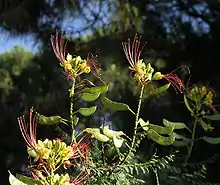Taxonavigation
| Taxonavigation: Fabales |
|---|
| Classification System: APG IV
Superregnum: Eukaryota |
Familia: Fabaceae
Subfamilia: Caesalpinioideae
Tribus: Acacieae – Caesalpinieae – Cassieae – Ingeae – Tachigalieae
Overview of genera
Caesalpinioideae s.s.: Acrocarpus –
Arapatiella –
Arcoa –
Arquita –
Balsamocarpon –
Batesia –
Biancaea –
Burkea –
Bussea –
Caesalpinia –
Campsiandra –
Cassia –
Cenostigma –
Ceratonia –
Chamaecrista –
Colvillea –
Conzattia –
Cordeauxia –
Coulteria –
Delonix –
Denisophytum –
Dimorphandra –
Diptychandra –
Erythrophleum –
Erythrostemon –
Gelrebia –
Gleditsia –
Guilandina –
Gymnocladus –
Haematoxylum –
Hererolandia –
Heteroflorum –
Hoffmannseggia –
Hultholia –
Jacqueshuberia –
Lemuropisum –
Libidibia –
Lophocarpinia –
Melanoxylum –
Mezoneuron –
Moldenhawera –
Mora –
Moullava –
Orphanodendron –
Pachyelasma –
Parkinsonia –
Paubrasilia –
Peltophorum –
Poeppigia –
Pomaria –
Pterogyne –
Pterolobium –
Recordoxylon –
Schizolobium –
Senna –
Stachyothyrsus –
Stahlia –
Stenodrepanum –
Stuhlmannia –
Sympetalandra –
Tachigali –
Tara –
Tetrapterocarpon –
Umtiza –
Vouacapoua –
Zuccagnia
The mimosoid clade: Abarema –
Acacia –
Acaciella –
Adenanthera –
Adenopodia –
Alantsilodendron –
Albizia –
Amblygonocarpus –
Anadenanthera –
Archidendron –
Archidendropsis –
Aubrevillea –
Balizia –
Blanchetiodendron –
Calliandra –
Calliandropsis –
Calpocalyx –
Cathormion –
Cedrelinga –
Chidlowia –
Chloroleucon –
Cojoba –
Cylicodiscus –
Desmanthus –
Dichrostachys –
Dinizia –
Ebenopsis –
Elephantorrhiza –
Entada –
Enterolobium –
Faidherbia –
Falcataria –
Fillaeopsis –
Gagnebina –
Guinetia –
Havardia –
Hesperalbizia –
Hydrochorea –
Indopiptadenia –
Inga –
Kanaloa –
Lachesiodendron –
Lemurodendron –
Leucaena –
Leucochloron –
Lysiloma –
Macrosamanea –
Mariosousa –
Marmaroxylon –
Microlobius –
Mimosa –
Mimozyganthus –
Neptunia –
Newtonia –
Painteria –
Parapiptadenia –
Pararchidendron –
Parasenegalia –
Paraserianthes –
Parkia –
Pentaclethra –
Piptadenia –
Piptadeniastrum –
Piptadeniopsis –
Pithecellobium –
Pityrocarpa –
Plathymenia –
Prosopidastrum –
Prosopis –
Pseudopiptadenia –
Pseudoprosopis –
Pseudosamanea –
Pseudosenegalia –
Samanea –
Schleinitzia –
Senegalia –
Serianthes –
Sphinga –
Stryphnodendron –
Tetrapleura –
Thailentadopsis –
Vachellia –
Viguieranthus –
Wallaceodendron –
Xerocladia –
Xylia –
Zapoteca –
Zygia
Name
Caesalpinioideae DC. Prodr. 2: 473. (1825)
- Type genus: Caesalpinia L. Sp. Pl. 1: 380 (1753)
Synonyms
- Homotypic
- Caesalpinieae Rchb., Fl. Germ. Excurs. 2(2): 544. (1832)
- Heterotypic
- Cassioideae Burmeist., Handb. Naturgesch.: 319. (1837) (“Cassieae”)
- Cassieae Bronn Form. Pl. Legumin. 78, 127, 130. (1822)
- Type: Cassia L., nom. cons.
- Ceratonieae Rchb. (1832)
- Dimorphandreae Benth. (1840)
- Sclerolobieae Benth. (1865)
- Moreae Britton & Rose (1930)
- Mimosoideae DC., Prodr. 2: 424. (1825)
- Mimoseae Bronn (1822)
- Type: Mimosa L.
- Parkieae (Wight & Arn.) Endl.
- Adenanthereae (Benth.) Benth. & Hook.f.
- Piptadenieae Benth
- Mimozygantheae Burkart (1939)
Note: See Discussion Page, but it is too early to place Dimorphandreae and Mimoseae here as distinct tribes (Stevens, 2020), as the clade phylogeny have yet to produce a workable taxonomy.
References
Primary references
- De Candolle, A.P. 1825. Prodromus Systematis Naturalis Regni Vegetabilis 2: 473. BHL
Additional references
- Bruneau, A., Mercure, M., Lewis, G.P. & Herendeen, P.S. 2008. Phylogenetic patterns and diversification in the caesalpinioid legumes. Botany 86(7): 697–718. Abstract Reference page.
- Fougere Danezan, M., Maumont, S. & Bruneau, A. 2003. Phylogenetic relationships in resin-producing Detarieae inferred from molecular data and preliminary results for a biogeographic hypothesis. Advances in Legume Systematics 10: 161–180.
- Gagnon, E., Lewis, G.P., Sotuyo, J.S., Hughes, C.E. & Bruneau, A. 2013. A molecular phylogeny of Caesalpinia sensu lato: Increased sampling reveals new insights and more genera than expected. South African Journal of Botany 89: 111–127. DOI: 10.1016/j.sajb.2013.07.027
 . Reference page.
. Reference page. - Gagnon, E., Bruneau, A., Hughes, C.E., de Queiroz, L.P. & Lewis, G.P. 2016. A new generic system for the pantropical Caesalpinia group (Leguminosae). PhytoKeys 71: 1–160. DOI: 10.3897/phytokeys.71.9203 Full text HTML Reference page.
- Herendeen, P.S., Bruneau, A. & Lewis, G.P. 2003. Phylogenetic relationships in caesalpinioid legumes: a preliminary analysis based on morphological and molecular data. Advances in Legume Systematics 10: 37–62.
- Legume Phylogeny Working Group 2017. A new subfamily classification of the Leguminosae based on a taxonomically comprehensive phylogeny. Taxon 66(1): 44–77. DOI: 10.12705/661.3 PDF. Reference page.
- Luckow, M., Miller, J.T., Murphy, D.J. & Livshultz, T. 2003. A phylogenetic analysis of the Mimosoideae (Leguminosae) based on chloroplast DNA sequence data. Advances in Legume Systematics, part, 10, pp.197-220. Full text from ResearchGate Reference page.
- Manzanilla, V. & Bruneau, A. 2012. Phylogeny reconstruction in the Caesalpinieae grade (Leguminosae) based on duplicated copies of the sucrose synthase gene and plastid markers. Molecular Phylogenetics and Evolution 65(1): 149–162. DOI: 10.1016/j.ympev.2012.05.035 Full text PDF from ResearchGate Reference page.
- Miller, J.T. Terra, V., Riggins, C., Ebinger, J.E. & Seigler, D.S. 2017. Molecular Phylogenetics of Parasenegalia and Pseudosenegalia (Fabaceae: Mimosoideae). Systematic Botany 42(3): 465-469. DOI: 10.1600/036364417X696140 Reference page.
Links
- International Plant Names Index. 2022. Caesalpinioideae. Published online. Accessed: Sept. 28 2022.
- Stevens, P.F. 2001 onwards. Angiosperm Phylogeny Website. Version 14, July 2017 [and more or less continuously updated since]. Online. Reference page.
Vernacular names
Deutsch: Johannisbrotgewächse
македонски: Рогачовидни
русский: Цезальпиновые
українська: Цезальпінієві
| For more multimedia, look at Caesalpinioideae on Wikimedia Commons. |

